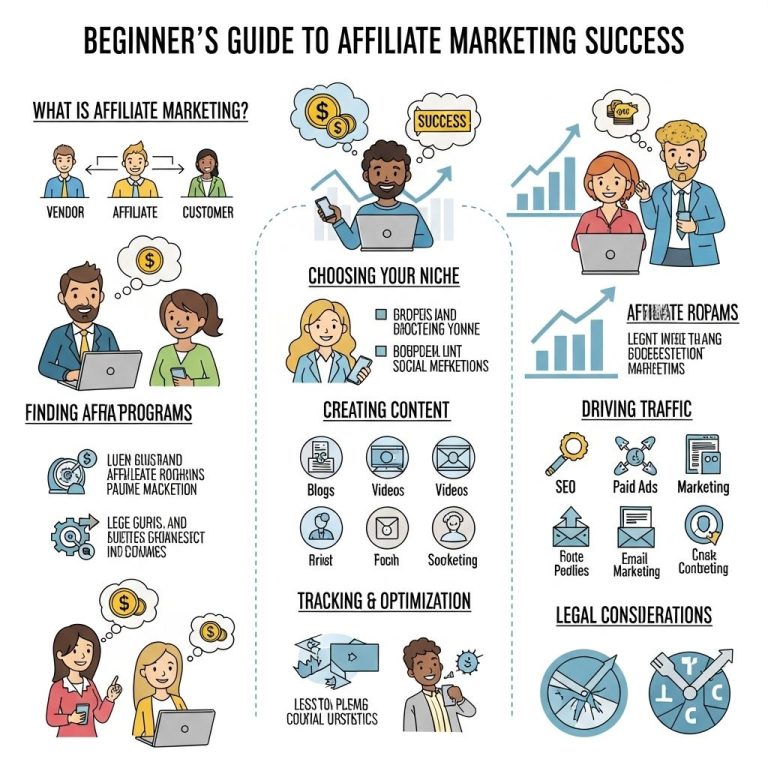In today’s digital landscape, the concept of earning passive income has gained immense popularity. Among the various methods available, affiliate marketing has emerged as a viable option for many individuals seeking financial independence. This article delves into the nuances of affiliate marketing, exploring how it works, the strategies to succeed, and the potential for generating a continuous income stream.
Understanding Affiliate Marketing
Affiliate marketing is a performance-based marketing strategy where an individual promotes a company’s products or services and earns a commission for each sale made through their referral. This model benefits both the merchant and the affiliate, creating a win-win scenario. Here’s a breakdown of how it typically works:
- Affiliate: A person or entity that promotes the products.
- Merchant: A company that sells the product or service.
- Affiliate Link: A unique URL provided to the affiliate to track referrals.
- Commission: The payment made to the affiliate for each sale.
The Key Players
To fully grasp affiliate marketing, it’s essential to identify the key players involved:
| Role | Description |
|---|---|
| Affiliate | Promotes products through various channels such as blogs, social media, and email. |
| Merchant | Offers products and sets up the affiliate program. |
| Affiliate Network | An intermediary that connects affiliates with merchants and provides tracking and payment solutions. |
Choosing the Right Niche
Selecting a niche is one of the most critical steps in affiliate marketing. A well-defined niche allows you to target a specific audience and establish authority. Here are some popular niches in the affiliate marketing space:
- Health and Wellness
- Personal Finance
- Technology and Gadgets
- Travel
- Fashion and Beauty
When choosing a niche, consider the following factors:
- Interest: Ensure it aligns with your passions or expertise.
- Demand: Research to see if there is sufficient market interest.
- Competition: Analyze the competition to find a balance—too much could make it hard to stand out.
Conducting Market Research
Market research is vital to understanding your target audience and ensuring your niche will be profitable. Here’s how you can conduct effective market research:
- Use tools like Google Trends to gauge interest over time.
- Check forums and social media groups to understand the needs and pain points of your audience.
- Analyze competitors to see what strategies they are implementing.
Building an Online Presence
Once you’ve chosen your niche, the next step is to establish a credible online presence. This can be done through various channels:
Creating a Blog
A blog is a powerful platform for affiliate marketing. It allows you to share valuable content while promoting products. Here’s how to get started:
- Select a Domain Name: Choose a name that reflects your niche.
- Choose a Hosting Service: There are many reliable hosting services available.
- Install a Content Management System: WordPress is a popular choice due to its user-friendly interface.
Utilizing Social Media
Social media platforms are excellent for reaching a broader audience. Consider the following:
- Instagram: Perfect for visual products like fashion or food.
- Facebook: Great for community building and sharing detailed content.
- Twitter: Useful for sharing quick updates and links to your offers.
Content Creation Strategies
High-quality content is paramount in engaging your audience and driving conversions. Here are several strategies to create compelling content:
Product Reviews
Writing in-depth reviews can help potential buyers make informed decisions. Consider the following structure:
- Introduction: Briefly introduce the product and its relevance.
- Pros and Cons: List the advantages and disadvantages of the product.
- Personal Experience: Share your own experience with the product.
Tutorials and How-To Guides
Providing valuable tutorials can establish you as an authority in your niche. Ensure your guides are:
- Step-by-step and easy to follow.
- Incorporate affiliate links naturally within the content.
Strategies for Driving Traffic
Search Engine Optimization (SEO)
SEO enhances your content’s visibility in search engines. Focus on:
- Keyword research to find terms your audience is searching for.
- On-page SEO techniques, including meta descriptions and internal linking.
- Building backlinks to increase your site’s authority.
Email Marketing
Email marketing is a powerful tool for affiliate marketing. Here’s how to build an effective email list:
- Offer a Lead Magnet: Provide a free resource in exchange for email subscriptions.
- Segment Your Audience: Tailor your emails based on subscriber interests.
- Include Calls to Action: Encourage readers to click on your affiliate links.
Tracking and Analyzing Performance
Understanding the performance of your affiliate marketing efforts is crucial. Use tools like Google Analytics and affiliate dashboards to track:
- Traffic sources
- Conversion rates
- Popular content
Adjusting Strategies
Based on your analysis, be prepared to adjust your strategies. Experiment with different types of content, promotional methods, and traffic sources to optimize results.
Scaling Your Affiliate Marketing Business
Once you find success in affiliate marketing, scaling is the next logical step. Consider the following approaches:
- Diversifying Income Streams: Explore multiple affiliate programs within your niche.
- Investing in Paid Advertising: Consider using pay-per-click advertising to drive significant traffic.
- Collaborating with Other Affiliates: Partnering can expand your reach and credibility.
Conclusion
Affiliate marketing presents a tremendous opportunity for earning passive income. By understanding the fundamentals, choosing the right niche, building a solid online presence, and continually optimizing your strategies, you can create a sustainable income stream. Remember, patience and persistence are key, as success in affiliate marketing is a journey of continuous learning and experimentation.
FAQ
What is affiliate marketing?
Affiliate marketing is a performance-based marketing strategy where an individual promotes a company’s products or services and earns a commission for each sale or lead generated through their referral.
How can I start earning passive income through affiliate marketing?
To start earning passive income through affiliate marketing, choose a niche, create a website or blog, sign up for affiliate programs, promote the products through content, and drive traffic to your site.
What are the best affiliate programs for beginners?
Some of the best affiliate programs for beginners include Amazon Associates, ShareASale, CJ Affiliate, and Rakuten Marketing due to their user-friendly interfaces and wide range of products.
How much can I earn with affiliate marketing?
Earnings from affiliate marketing vary widely; some affiliates earn a few dollars a month, while others can make thousands, depending on their niche, traffic, and marketing strategies.
Is affiliate marketing a sustainable source of passive income?
Yes, affiliate marketing can be a sustainable source of passive income if you consistently create high-quality content, engage with your audience, and adapt to market changes.
What are common mistakes to avoid in affiliate marketing?
Common mistakes to avoid in affiliate marketing include promoting low-quality products, neglecting SEO, failing to disclose affiliate relationships, and not tracking performance metrics.




